ikfoundation.org
The IK Foundation
Promoting Natural & Cultural History
Since 1988




“
The mountains appear to be shaped like a prism
andstand in a long line, parallel to one another,
between which are snow-filled valleys.
”
SPITSBERGEN 25th of June 1758. ANTON ROLANDSSON MARTIN

INDEX
VOYAGE
VOYAGE DETAILS
VOYAGE I (2016)
VOYAGE II (2017)
VOYAGE III (2018)
VOYAGE IV (2019)
VOYAGE V (2020)
VOYAGE III | FIELDWORK INFORMATION | 4th September to 10th September, 2018
The expedition – Voyage III – was carried out in September 2018 during a fieldwork period of five days and to be continued with a five-day fieldwork period in May 2019 (Voyage IV:A). The project used the ice-strengthened ship M/S Malmö as a platform for all of the expedition participants, transport, fieldwork and communication alike. Field documentation at Forlandsøyane | Prins Karls Forland (pictures, artwork and text) of the coastal area, particularly research area A-B, for reference studies of Anton Rolandsson Martin's visit in the area 1758. Coastal survey and identification of site options for FIELD STATION | NATURAE OBSERVATIO project, version III. Field work: Fauna, flora, astronomy, meteorology and biosphere.
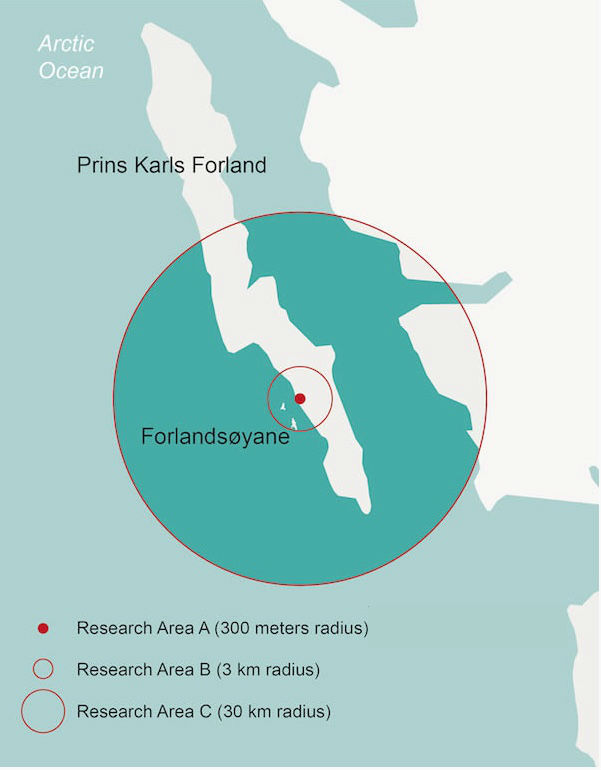
- LONGYEARBYEN:
Assembly/preparation for the fieldwork, meetings with regional institutions and embarking on the expedition ship M/S MALMÖ. - SKANSBUKTA:
Field documentation (pictures, artwork and text). Testing of field equipment and personal resources. - FORLANDSØYANE | PRINS KARLS FORLAND (West):
Field documentation (pictures, artwork and text) of the coastal area, research area A-B, for reference studies of Anton Rolandsson Martin's visit in the area 1758. Coastal survey for and identification of site options for the FIELD STATION | NATURAE OBSERVATIO project, version III. Field work: Fauna, flora, astronomy, meteorology and biosphere. - FORLANDSUNDET | PRINS KARLS FORLAND (East):
Field documentation (pictures, artwork and text) of the Forlandsundets east coast between Kvadehuken och Daudmannsodden (including research area C). - SAINT JONSFJORDEN | OSBORNEBREEN:
Field documentation (pictures, artwork and text). - LONGYEARBYEN:
Field documentation (pictures, artwork and text) of the coastal area. Return to base.
INITIAL FIELD REPORTS
SURVEY ALONG THE EASTERN COAST OF FORLANDSUNDET
Introduction
In the period September 4 to 10, the Bridge Builder Expedition Spitsbergen project FIELD STATION | NATURAE OBSERVATIO performed field work along the west coast of Prins Karls Forland and the eastern part of the Forlandsundet. A full day, Friday September 7, was dedicated to a survey for alternative sites for our field station (v.II). In this regard, the eastern shoreline of the Forlandsundet was inspected. Included was the part of the shore situated between approximate latitudes 78 degrees 18 minutes N and 78 degrees 52 minutes N.
Survey work Friday September 7
Starting at 08:45, M/S Malmö proceeded at slow speed, 10 knots, along the relevant part of the west coast of Spitsbergen. The coastal line was all the time inspected and evaluated with respect to site attraction. All expedition participants were involved in different aspects of this work.
From the bridge of the vessel, detailed evaluation of the coastal line was made. The assessment included shoreline adequacy regarding seal friendliness and zodiac landing facilities. In addition, judgement was made of the onshore terrain, its topography, flora and general suitability for interesting animal species. In this regard, animals taken into account were birds, reindeers and foxes as well as polar bears, with walruses as possible additions. Other important considerations concerned availability of suitable local hills for site establishment and corresponding free horizon. All the time, the coast was surveyed for signs of human activities, such as hunting or other field work. Places with such signs were ruled out as tentative field station sites.
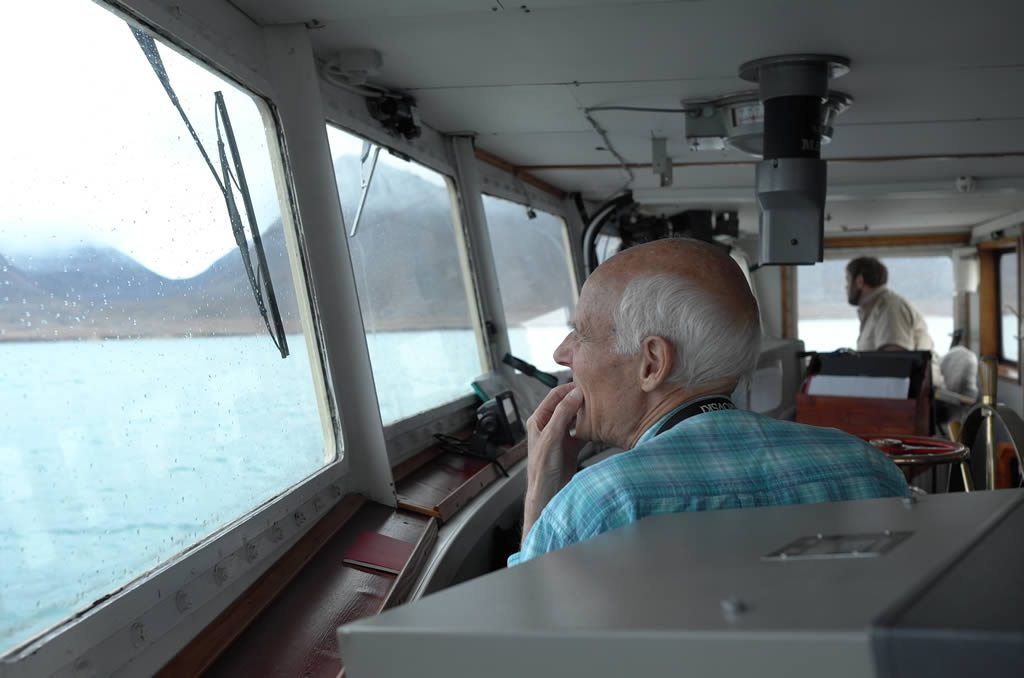 From the bridge of the vessel, detailed evaluation of the coastal line was made. PHOTO: Lars Hansen | Bridge Builder Expeditions Spitsbergen, Voyage III, 2018.
From the bridge of the vessel, detailed evaluation of the coastal line was made. PHOTO: Lars Hansen | Bridge Builder Expeditions Spitsbergen, Voyage III, 2018. From the starboard deck, and occasionally also from the port deck, the coastal line was inspected for presence of animals. Notes were taken of larger amounts of birds, visible bird nests, seals, reindeers and foxes. While all these features were identified, sometimes in abundant quantities, neither polar bears nor walruses were detected. In addition, from the deck, photographs were taken and field artist work made. All the time, bridge and deck inspections were made in dialogue.
In case of places especially interesting, the speed of M/S Malmö was reduced. In case of the most attractive places, the ship was brought to a standstill to allow closer inspection. This occurred at several occasions.
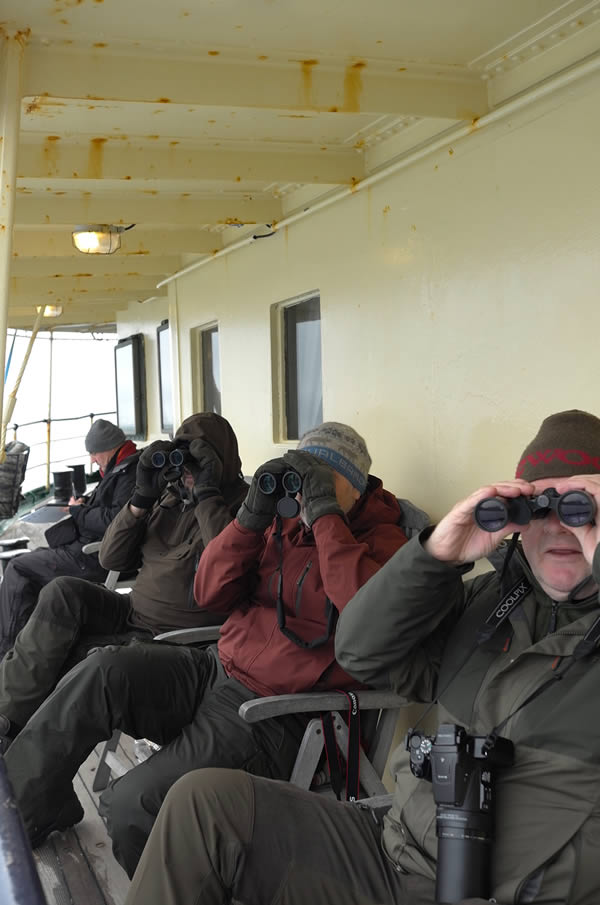 All the time, bridge and deck inspections were made in dialogue. PHOTO: Lars Hansen | Bridge Builder Expeditions Spitsbergen, Voyage III, 2018.
All the time, bridge and deck inspections were made in dialogue. PHOTO: Lars Hansen | Bridge Builder Expeditions Spitsbergen, Voyage III, 2018.
During the day, a total of eleven places were subjected to closer inspection. These places were described in some detail. Coordinates, longitude and latitude, were noted. Short descriptions were made. In all cases, notes were made of shoreline and onshore terrain qualities as well as presence of local hills suitable for field station establishment. Corresponding amounts of free horizon were estimated. Presence of animals were added, regularly including birds, often reindeers and sometimes seals and foxes.
The eleven places closely inspected were all rated concerning their overall quality as site candidates. A five-degree scale was adopted. Two places were judged as exceptionally promising, given ratings of five and four, respectively. The place highest rated, Hermansøya, is, however, a bird sanctuary. As such, it is most probably not eligible. This remains to be verified.
A favourite site
The site rated as four on our suitability scale is situated rather close to Hermansøya. It is a small isthmus, protruding in the North-North-West direction. The length of the isthmus is around 800 metres and the corresponding width of the order of 350 metres. Along the middle part of the isthmus, there are soft hills reaching between ten and twenty metres above sea level. With a zodiac, the place can be easily reached. This regards both coastal lines, the western as well as the eastern part.
Both the coastal line and the onshore terrain appear ideal for seals and for reindeers, respectively. The flora is reasonably abundant. Several hill positions seem highly adequate as sites for our field station. All of them offer ease of access as well as ideal horizon coverage.
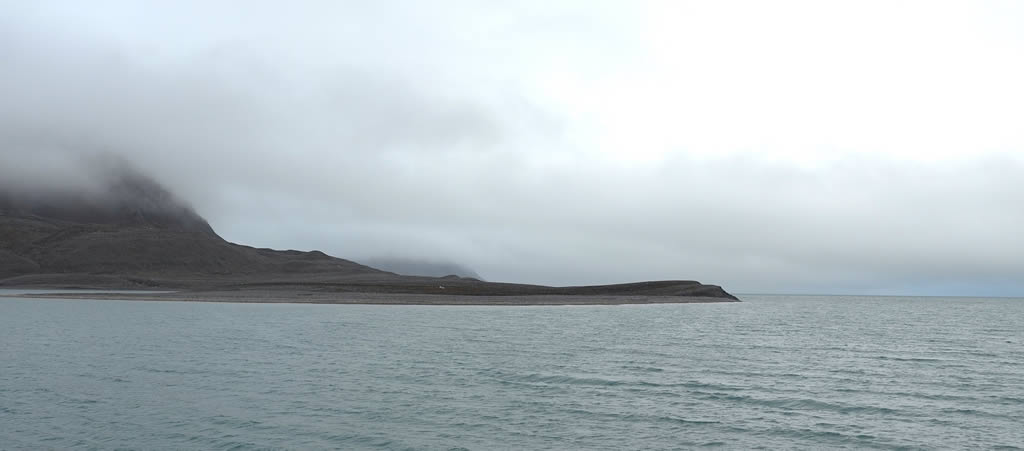 Isthmus in Dahlbrebukta. PHOTO: Lars Hansen | Bridge Builder Expeditions Spitsbergen, Voyage III, 2018.
Isthmus in Dahlbrebukta. PHOTO: Lars Hansen | Bridge Builder Expeditions Spitsbergen, Voyage III, 2018. A substantial advantage of this site is its closeness to Hermansøya. The distance allows rather favourable surveys of the amount of birds nesting in the island. Monitoring of bird presence as a function of season seems a very attractive possibility. Another advantage of the isthmus site is the relative closeness to the Dahlbreen glacier. This is a prominent glacier. From the isthmus, at an approximate distance from the glacier of five kilometres, it can be observed in some detail as well as from a more overall perspective.
Generous photographic and artist documentation of the place were made. The site candidate was left at around 18:00. This completed our Friday survey for promising site candidates. However, due to the favourable impressions of the isthmus site candidate, it was visited also on Sunday September 9. At this occasion, the promising qualities of the place could be fully confirmed. M/S Malmö was manoeuvred to allow optimum inspection of site details. Anew, photographs were recorded and field artist work performed.
Arne Ardeberg
PRACTICAL ASPECTS ON ARCTIC TRAVELS – 1750s TO 1820s
During Voyage III, I particularly experienced first hand comparable situations with the earlier travellers linked to the freezing Arctic climate – if being in the open air on the mothership, in a zodiac or during landing on Nordøya, one of three small islands of Forlandsøyane, situated west of Spitsbergen. A beautiful rugged mountainous landscape with thousands of glaciers contrasting with fjords and wetland vegetation. Despite the constant cold for the 18th century sailing ships, the travellers may have had some advantage of gradually getting used to the rolling sea and changing climes stretching over a month or more up to making it to the destination. When they finally reached land in the Spitsbergen area, further obstacles were ever more present and inlets were dangerous to enter if ice free. It was probably not seen as worth the risk to use a small rowing boat with some of the crew to make a rather long hazardous journey into the coast – just due to a natural historians’ interest of botanical or geological specimens – if the captain was not gaining plenty of nutrition for the crew, like eiders and eider eggs. To be a guest in a geographical area of the polar bears is another danger, great care must be taken in a small boat and on land alike, in the 18th century as well as today.
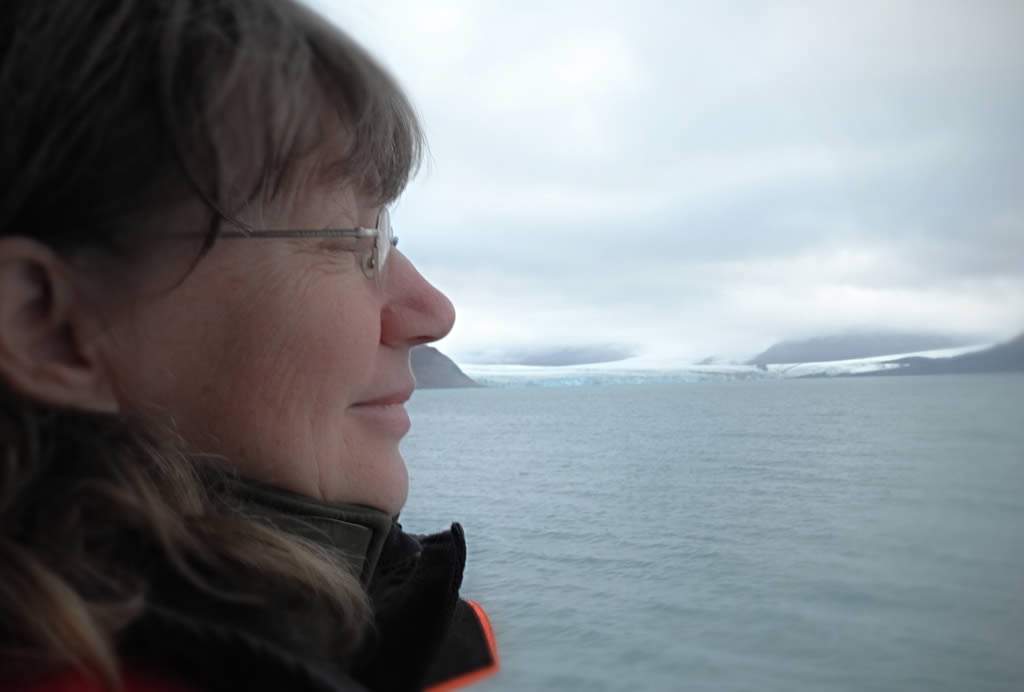 As a participant on Bridge Builder Expedition – Spitsbergen (Svalbard) Voyage III, my aim was to get an increased understanding for natural history travels via the Arctic seafaring routes along the west coast of Spitsbergen, emphasising on practical aspects of personal belongings and collections. The five-day field voyage gave new-learned knowledge on waterproof clothing, the difficulty to estimate distances, transports and seasickness – as I suffered from myself in these waters. Additionally focusing on notes made by the naturalist Anton Rolandsson Martin who found it difficult to keep warm on a whaling ship in the area 1758 and a few other contemporary travellers’ observations. PHOTO: Lars Hansen | Bridge Builder Expeditions Spitsbergen, Voyage III, 2018.
As a participant on Bridge Builder Expedition – Spitsbergen (Svalbard) Voyage III, my aim was to get an increased understanding for natural history travels via the Arctic seafaring routes along the west coast of Spitsbergen, emphasising on practical aspects of personal belongings and collections. The five-day field voyage gave new-learned knowledge on waterproof clothing, the difficulty to estimate distances, transports and seasickness – as I suffered from myself in these waters. Additionally focusing on notes made by the naturalist Anton Rolandsson Martin who found it difficult to keep warm on a whaling ship in the area 1758 and a few other contemporary travellers’ observations. PHOTO: Lars Hansen | Bridge Builder Expeditions Spitsbergen, Voyage III, 2018. There was also an opportunity for me to assist Ulf Johansson with an inventory of bird nests on Forlandsøyane and to make a presentation of the ongoing project Personal belongings and collections on 18th century travels. The hope is to able to take part in an upcoming Bridge Builder Expedition next year to get further experience of sea voyages in Arctic waters and the use of suitable waterproof and warm clothing for such temperatures from an interdisciplinary historical perspective.
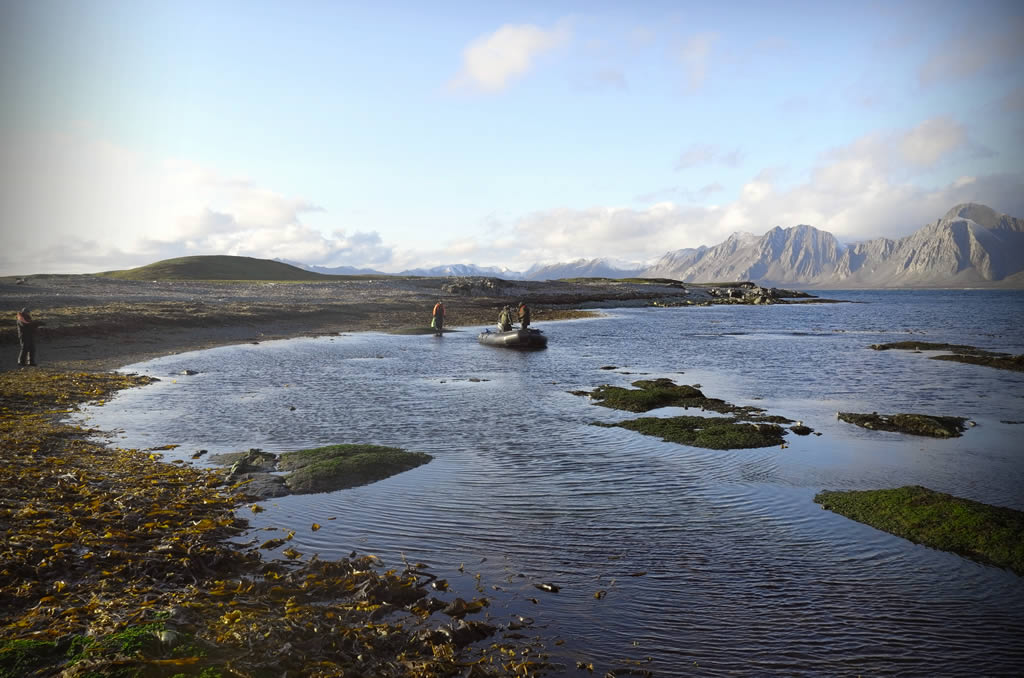 Landing on Nordøya, one of three small islands of the remote coastal landscape Forlandsøyane, situated west of Spitsbergen on 6 September 2018. PHOTO: Lars Hansen | Bridge Builder Expeditions Spitsbergen, Voyage III, 2018.
Landing on Nordøya, one of three small islands of the remote coastal landscape Forlandsøyane, situated west of Spitsbergen on 6 September 2018. PHOTO: Lars Hansen | Bridge Builder Expeditions Spitsbergen, Voyage III, 2018. Read more about this geographical area in my recently published essay on iTEXTILIS: ‘Eiderdown, Woollen Clothes & Furs – Practical aspects on Journeys to Spitsbergen 1750s to 1820s’.
Viveka Hansen
TEST OF PANORAMIC PHOTOGRAPHIC MONITORING
In the preparation work of adding a system of wide-angle cameras to the Field Station | Naturae Observatio project, a test program was carried out during this year's field work in the area around and on the Forelandsøyane. During two field days, two different camera systems were tested.
Test 1: For high-definition documentation, Leica Monochrome was used for monochrome images and a Leica X-U for colour photography. These cameras were placed at the highest point (13 meters above sea level) on the Nordøya (Lat: N 78 21.5095' Lon: E 11 31.5346’). A number of sequences with different filters were carried out from the site, offering a magnificent 360 degree view of the coastal landscape, with the inner lowland Forlandsletta, with surrounding mountains and sea areas.
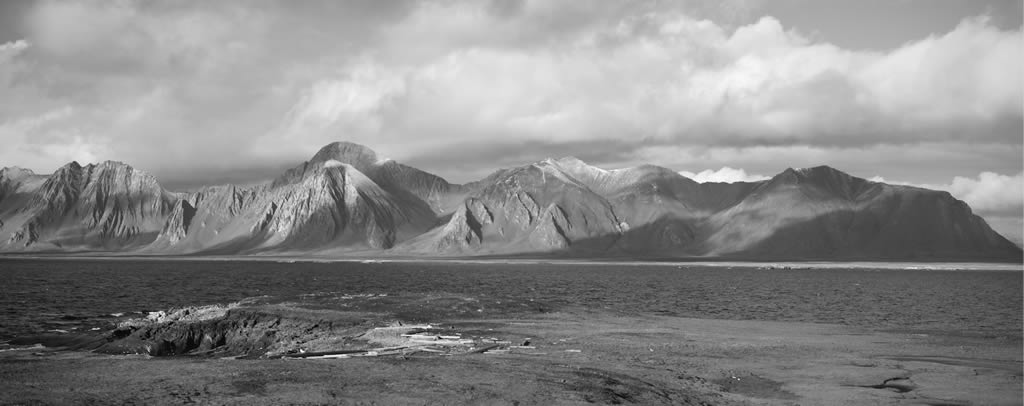
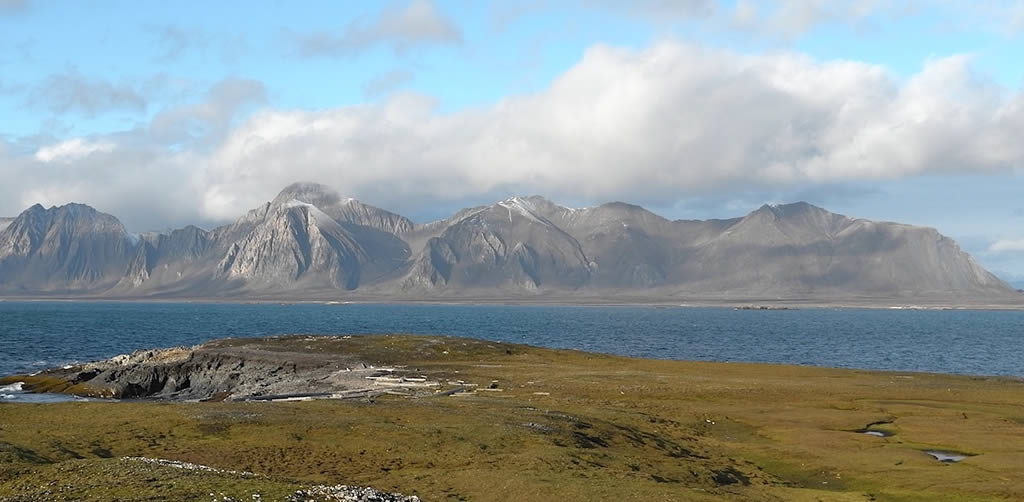 Basic wide-angle photography in monochrome and colour: North. | Photographed from the highest point at Nordøya. PHOTO: Lars Hansen | Bridge Builder Expeditions Spitsbergen, Voyage III, 2018.
Basic wide-angle photography in monochrome and colour: North. | Photographed from the highest point at Nordøya. PHOTO: Lars Hansen | Bridge Builder Expeditions Spitsbergen, Voyage III, 2018.Simultaneously with this photographic documentation, the project's field artist carried out the same wide-angle documentation seen through an artist's eye. The unusually fine and clear weather gave us great opportunities for an excellent and comprehensive basis of evaluation for future implementation of a camera system at the field station.
 The project's field artist, Måns Bergendal, carried out the same wide-angle documentation seen through an artist's eye. PHOTO: The IK Foundation/Estvall/Photo stitching Graham Scott | Bridge Builder Expeditions Spitsbergen, Voyage III, 2018.
The project's field artist, Måns Bergendal, carried out the same wide-angle documentation seen through an artist's eye. PHOTO: The IK Foundation/Estvall/Photo stitching Graham Scott | Bridge Builder Expeditions Spitsbergen, Voyage III, 2018. Test 2: Day two offered more "normal" weather for the area – gusts, rain and poor visibility. Test was conducted with an automated time-lapse camera at the coastal area on the west side of Forlandsletta in front of the Forland Islands. The camera, GoPro Fusion, was placed on a three meter high tripod where it was left to document the near area as well as the "larger" surrounding landscape.
This test gave the project proof for that it is possible to perform time-laps for close and remote objects alike. However, there are several challenges of practical nature, such as access to energy, data storage capacity and such a normally uncomplicated task as to keep the lenses on the cameras clean! With this test we can now develop a system that will handle these matters during the coming planned field period. A period for implementing the project goals.
GOALS
The project has two goals in the research areas (Area A up to B = approx. 3 km radius) and the third area (Area C = approx. 30 km radius) from Field Station | Naturae Observatio, using panoramic digital HD photographs: (I) Continuous photographing of selected areas of the landscape for a field period, to closely follow the fauna, flora and the elements (the local biosphere). (II) To provide documentary research support for other ongoing research projects related to the Field Station: in the disciplines of biology, meteorology and astronomy.
Lars Hansen | Bridge Builder Expeditions Spitsbergen, Voyage III | Click here for more Panoramic Pictures
The project scheme proposed includes advanced and long-term panoramic photographic documentation on selected parts of the landscape, and documenting of an annual cycle of the lithosphere, hydrosphere and atmosphere (the local biosphere) through a firmly installed special camera equipment. To thereby increase knowledge about the area's local biosphere, whilst the documentation is an important complement to other ongoing multidisciplinary research projects linked to Field Station | Naturae Observatio.
Through an automated system, for the first time, we can get in-depth documentation about the local biosphere system of the area. Observation data that can contribute to an increased interdisciplinary understanding of one of the world's remaining wild and "unspoiled" areas. Observation data complements the ongoing research project, but is also made available to future projects and interested organisations and individuals.
Lars Hansen
INVENTORY OF BIRD NESTS
Forlandsletta and Forlandsøyana are important breeding sites for many species of birds on Svalbard. About 35-40 species regularly occur in the area, and several of these species can be found in high densities. All of these species leave the area during the Svalbard winter, but arrives back at different times during the spring to breed on these islands or in neighbouring areas. As this area is difficult to access when the first species arrive, the arrival dates of these species are not well known. In order to track the arrival dates of the species breeding and regularly passing this area, an Automated Sound Recorder is planned to be mounted in association with the Field Station | Naturae Observatio. One of the aims of this project is to record the activity of these species. However, noisy and loud species, such as geese, or large colonies of breeding birds may drown the sound of more faint sounding species, and thus influence the probability to detect the presence of these species. It is obviously difficult to predict the movements and local aggregations of birds within a specific area, but for instance nest colonies are one such obvious local accumulation. Many species build non-permanent structures or no nest at all, and are thus not detectable after the breeding season. However, some species such as geese and eiders build small mounds with shallow depression on top, which are reused year after year and thus often forming conspicuous structures
 Inventory of bird nests on Nordøya. PHOTO: Lars Hansen | Bridge Builder Expeditions Spitsbergen, Voyage III, 2018.
Inventory of bird nests on Nordøya. PHOTO: Lars Hansen | Bridge Builder Expeditions Spitsbergen, Voyage III, 2018. on the ground. In order to get an initial idea of the expected concentration of birds around the planned version 3 of the Field Station | Naturae Observatio, an inventory of the visible nest structure was conducted near this site and compared with a similar area on Nordøya (Forlandsøyana). Eight 20 x 20 m2 squares, four on Nordøya and four on Forlandsletta, were randomly selected and all nest structures within these squares were counted. All squares on Nordøya contained nests (3, 8, 2, <50), whereas none of the squares on Forlandet contained any visible nest structures. This large difference between Nordøya and Forlandet is probably due to a higher predation pressure on the much bigger island of Forlandet.
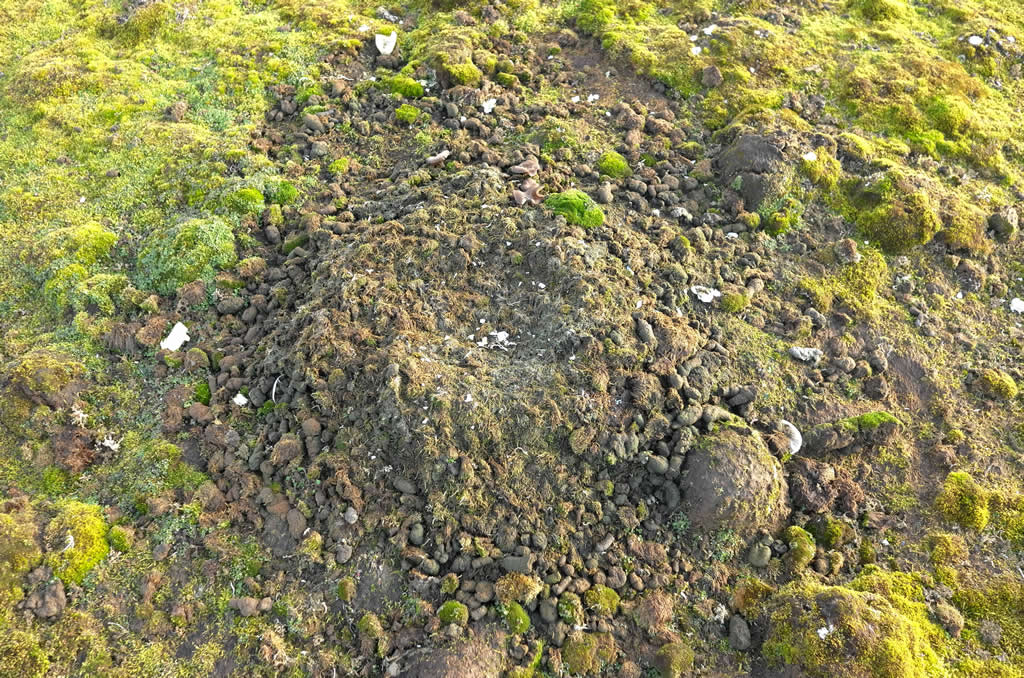 Nest, likely from a goose. Frequent re-use results in a constantly crowing nest structure basically built up out of the bird’s own droppings. During breeding season nest lined with large amounts of down. PHOTO: Lars Hansen | Bridge Builder Expeditions Spitsbergen, Voyage III, 2018.
Nest, likely from a goose. Frequent re-use results in a constantly crowing nest structure basically built up out of the bird’s own droppings. During breeding season nest lined with large amounts of down. PHOTO: Lars Hansen | Bridge Builder Expeditions Spitsbergen, Voyage III, 2018. Ulf Johansson
THE FIELD ARTIST’S INITIAL REPORT
Compared to the two previous Bridge Builder Expeditions to Spitsbergen, this year’s watercolour artistry was facilitated by a choice of materials that better suites being carried around. I brought a watercolour block and a reduced palette comprising mostly pigments that were known and used during the heyday of exploration and before the camera was invented. A single, well chosen Escoda último n:o 10 was used for all of the brushwork.
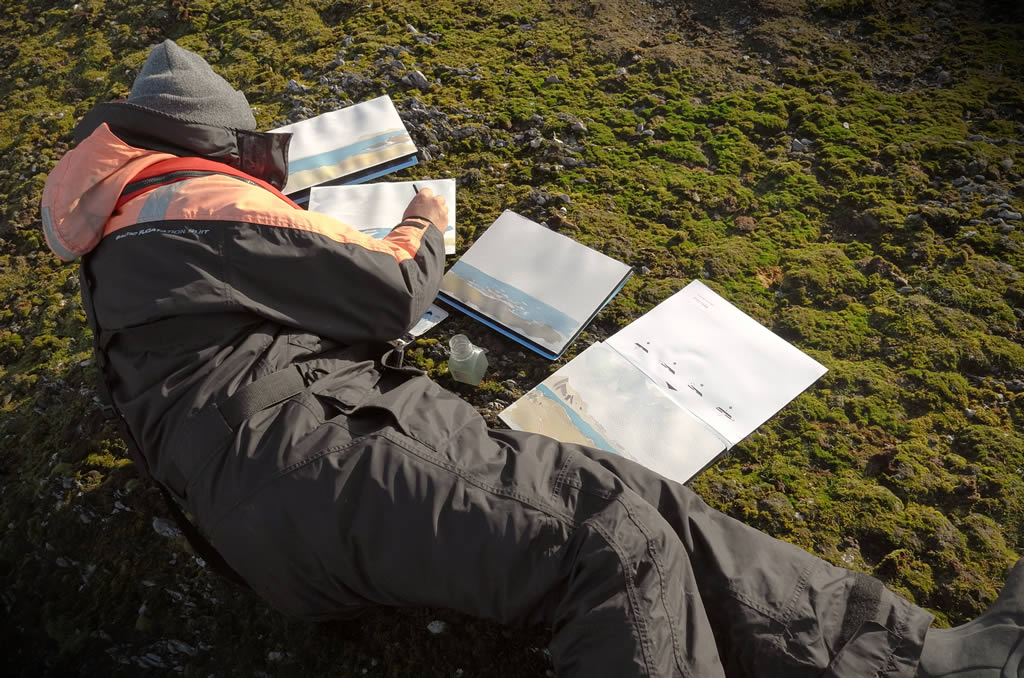 Nordøya. PHOTO: Lars Hansen | Bridge Builder Expeditions Spitsbergen, Voyage III, 2018.
Nordøya. PHOTO: Lars Hansen | Bridge Builder Expeditions Spitsbergen, Voyage III, 2018. Further notes were taken concerning field adaptations and will be taken into consideration when preparations for the next expedition are being made. These may include an even more limited set of colours, a smaller paint box and a softer pencil. The all-round knife will be exchanged for a Swiss army knife whose one-sided chamfer is expected to be more efficient for removing the paper from the block when the painting has dried. However, the wrist gaiters defend their spot in the daypack efficiently by keeping my hands warm. Likewise, the daypack will continue to serve as an easel and simplicity and immediacy remain the lodestars.
Subject matter has been focused on the mammal and avian fauna in north-west Spitsbergen including the harbour seals at the island of Nordøya, reindeer grazing on the coastal plains and a number of birds such as the fulmar, a species that is seen foraging around the boat at all times. The Linnaeus scholar Anton Rolandsson Martin observed and described it on board the whaler ”de Visser” in 1758. Furthermore, one of the many great skuas and a red-throated loon made excellent models while passing by in mid-air. While waiting in the harbour I got an opportunity to paint a flock of pink-footed geese that was grazing by the Longyear river and a single barnacle goose, as well as a black guillemot in its first winter plumage.
Field artist Måns Bergendal | PHOTO: The IK Foundation/Estvall | Bridge Builder Expeditions Spitsbergen, Voyage III | Click here for more Pictures
On Nordøya I made a few quick and sketchy panorama paintings accompanying the photographic ones made at the same spot. Other motifs embodied the boat wreck in Skansbukta as well as the foggy sea shores of Oscar II Land. A number of black-and-white pencil drawings of coast profiles were also made during transportation to and from the Forland islands and the western shore of Prins Karls Forland.
Finally, the varying weather conditions rendered possibilities to paint in different light conditions such as mist, backlight and haze, and just like last year, drizzle took part in the landscape painting of the Forlandsletta and gave the washes a mottled appearance.
Måns Bergendal
THE PARTICIPANTS
EXPEDITION PARTICIPANTS

Arne Ardeberg
- (b.) 1940
- DUTY: Participant, researcher.
- AIM: Monitoring of Aurora Developments. Studies of Noctilucent Clouds. Recording of Meteors. Coordination of Science Projects and Technical Installations.
- POST: Professor emeritus in Astrophysics, Lund University, Sweden. Member of Royal Swedish Academy of Sciences, Royal Physiographic Society, Royal Society of Sciences, Chair of Crafoord Prize Committee in Astronomy and LMK-stiftelsen, Foundation for Interdisciplinary Scientific Research.
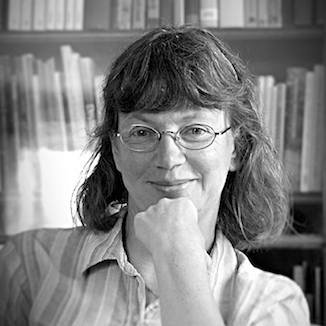
Viveka Hansen
- (b.) 1962
- DUTY: Participant, researcher.
- AIM: My aim is to get an increased understanding for natural history travels via the Arctic seafaring routes along the west coast of Spitsbergen – emphasising on practical aspects of personal belongings, 1750s to 1820s.
- POST: Textile Historian and Writer. The IK Foundation & (FLS), London, United Kingdom.

Lars Hansen
- (b.) 1960
- DUTY: Expedition leader, researcher.
- AIM: To strengthen our insight of the fieldwork that the so-called Linnaeus Apostles started almost three centuries ago. To understand Natural and Cultural History of Planet Earth – and hopefully building "new bridges of proficiency" between the past, present and future!
- POST: Head at The IK Foundation, FRGS, London, United Kingdom.
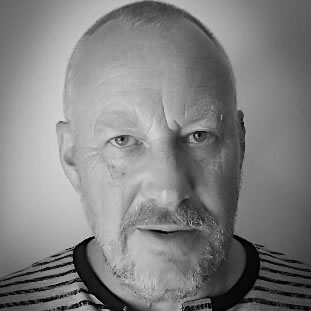
Dan Hansen
- (b.) 1954
- DUTY: Participant, field assistant.
- AIM: My main contribution to the expedition will be to serve for safety and assistance to the other members. At the same time, it will be an unforgettable experience to visit the landscape and people of Spitsbergen/Svalbard.
- POST: Optimisation consultant of operations in recycling and agriculture.
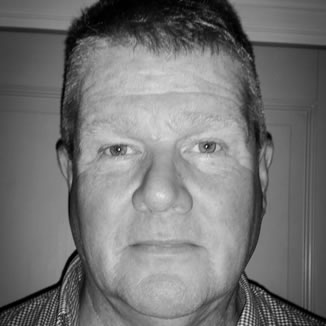
Mikael Hjelmqvist
- (b.) 1959
- DUTY: Participant, field assistant.
- AIM: My aim is to assist the other participants and create a secure working platform. It is a great opportunity to be able to follow an expedition to Spitsbergen/Svalbard.
- POST: Forest owner with focus on hunting and fishing. Bäck’s Forest Estate, Sweden.

Ulf Johansson
- (b.) 1970
- DUTY: Participant, researcher.
- AIM: (A) To carry out an inventory of bird nests on Forlandsøyane to be compared with a corresponding area on Forlandet. (B) Continue to collect information and document the travels of the earliest scientific explorers to Svalbard (1596-1799).
- POST: Curator of birds, Swedish Museum of Natural History.
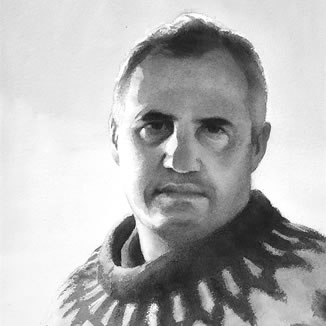
Måns Bergendal
- (b.) 1964
- DUTY: Participant, field artist.
- AIM: I want to convey what I see with immediacy and simplicity to make the viewer feel present on the Arctic scene. Watercolor is the most portable medium and an excellent one for this purpose.
- POST: Watercolour artist, illustrator and instructor, Lund, Sweden.
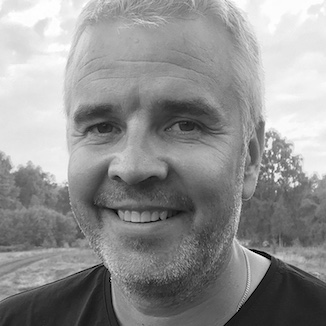
Mikael Sjögren
- (b.) 1970
- DUTY: Participant, field assistant.
- AIM: To assist the other members and to achieve a secure working environment. It will also be a great experience to visit Spitsbergen/Svalbard and see the nature and wildlife.
- POST: Project Manager / New development at CWP. Forest owner Hyltan Estate Sweden.
EXPEDITION SHIP CREW
- Master, Johannes Malmlund
- Chief Officer, Daniel Hallström
- AB, Theodor Feldt
- AB, Malin Beausang
- Chief Engineer, Håkan Reis
- Chef, Roger Häll
- Stewardess, Hanna Dahl
- Steward, Simon Granqvist
EXPEDITION BACK BASE
- Webmaster, digital network: Jeff Snoxell
- Art work: Graham Scott
- Controller: Jennie Asher
- Maritime lawyer: Bo Benell
- The Reception Desk: Leo Ryder
EXPEDITION PATRONS
- LMK-stiftelsen, Foundation for Interdisciplinary Scientific Research
- The IK Foundation
iPROJECTS
iPROJECTS
In The IK Foundation and The IK Workshop Society there are continually ongoing comprehensive projects, each having different character and format. In iPROJECTS the current works and ideas are presented - Expeditions, Fieldwork, Research, Presentation in progress, and much more... For regular updates, and to make full use of iLINNAEUS' possibilities, we recommend fellowship by subscribing to our monthly newsletter iMESSENGER.
NAME OF PROJECT
- (Main title) The Linnaeus Apostles BRIDGE BUILDER EXPEDITIONS To Understand Planet Earth
- (Subtitle) BRIDGE BUILDER EXPEDITIONS - Spitsbergen (Svalbard)
- FIELD STATION | NATURAE OBSERVATIO | MARTIN’S EYE
GEOGRAPHICAL SCOPE
- Spitsbergen, Svalbard; in the agreement of the international Spitsbergen treaty (Svalbard treaty)
SUBJECTS
- Geography
- 18th century Studies'
- Cultural History
- History of Science
- Natural History
- Economic History
- Field Notes, Arts and Photography
- Field station, long-term observations
- Ecology
INSTITUTIONAL RESOURCES
- The IK Foundation, London, United Kingdom
- Natural History Museum University of Stockholm, Sweden
- Grenna Museum Polarcenter, Sweden
- University of Gothenburg, Sweden
- The Norwegian Meteorological Institute, Norway
- Lund university, Sweden
- The Royal Geographical Society (with IBG), United Kingdom
- The Swedish Academy, Sweden
- Stockholm university, Sweden
- University of Tromsø, Norway
- INTERACT | International Network for Terrestrial Research and Monitoring in the Arctic, EU
- GBIF | Global Biodiversity Information Facility, Norway & United Kingdom
- Natural History Museum University of Oslo, Norway
- Department of Biology, Lund University, Sweden
- Lund Observatory, Department of Astronomy and Theoretical Physics, Lund University, Sweden
- UNIS Aurora Observatory: The Kjell Henriksen Observatory (KHO), Svalbard.
PATRONAGE
This site/project
has been made globally available in collaboration with:
 Feel welcome to read more about how to take part...
Feel welcome to read more about how to take part...
 Feel welcome to read more about how to take part...
Feel welcome to read more about how to take part...
TIMELINE
- 2016: Expedition Voyage I: Field work, research, documentation and follow-up work.
- 2017: Expedition Voyage II: Field work, research, documentation and follow-up work.
- 2018: Expedition Voyage III: Field work, research, documentation and follow-up work.
- 2019: Expedition Voyage IV:A (May) and Voyage IV:B (September/October): Field work, research, documentation and follow-up work.
- 2020: Expedition Voyage V: Dismantling of the Field Station, documentation and follow-up / planning of publicise work.
- 2021: Research, follow-up work, Publicise work of Publication | Exhibition | Multimedia, with the title NATURAE OBSERVATIO SPITSBERGEN | SCIENCE EXPEDITIONS | TEXTS & OBSERVATIONS FROM THE PAST TO PRESENT TIME.
- 2023/24: International launch of the publicise work of Publication | Exhibition | Multimedia, with the title NATURAE OBSERVATIO SPITSBERGEN | SCIENCE EXPEDITIONS | TEXTS & OBSERVATIONS FROM THE PAST TO PRESENT TIME.
PUBLICISE
- iLINNAEUS.org
- Publicise work of Publication | Exhibition | Multimedia, with the title NATURAE OBSERVATIO SPITSBERGEN | SCIENCE EXPEDITIONS | TEXTS & OBSERVATIONS FROM THE PAST TO PRESENT TIME.
- Field Station | Naturae Observatio
- Expedition Picture Portfolio
- Expedition Video Portfolio
- Expedition Panoramic Portfolio
LINKS | FURTHER READING
- Research in Svalbard (RIS)
- RIS-ID 10275 (Bridge Builder Expeditions Spitsbergen)
- RIS-ID 11055 (Field Station Research Projects)
- The Norwegian Polar Institute's topographical Svalbard map portal
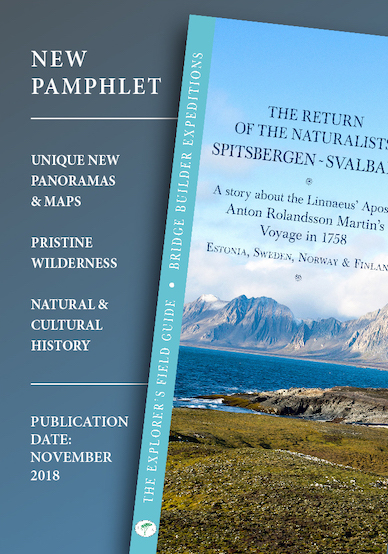
Updated/Checked 27/09/2023
THE IK FOUNDATION & COMPANY PROMOTING NATURAL & CULTURAL HISTORY
SUBSCRIBE TO OUR NEWSLETTER
TRANSLATE PAGE
A link to this page has
been copied to your clipboard
SHARE @been copied to your clipboard




© The IK Foundation & Company 2025
– a truly European organisation since 1988
– a truly European organisation since 1988
Legal issues | Forget me | and much more...
How to cite & Creative Commons
You are welcome to use the information and knowledge from
The IK Workshop Society, as long as you follow a few simple rules.
LEARN MORE & I AGREE
You are welcome to use the information and knowledge from
The IK Workshop Society, as long as you follow a few simple rules.
LEARN MORE & I AGREE












